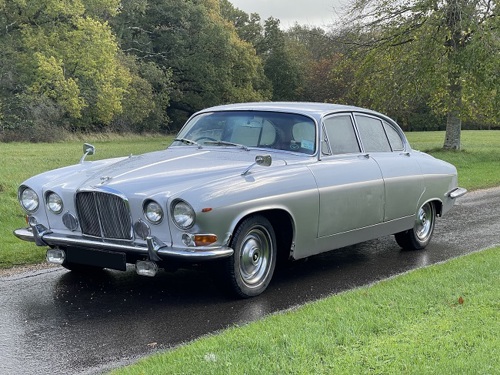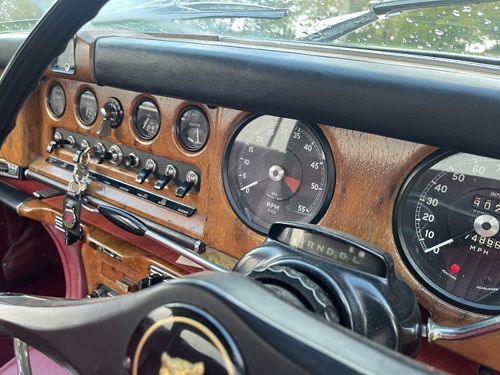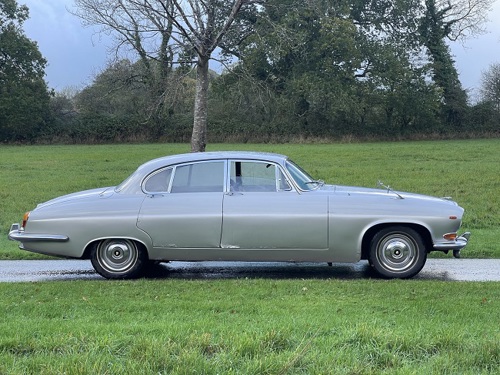THE LAST OF THE LINE – THE JAGUAR 420G
02 January 2025
Some years ago, I described the Mk. X in The Telegraph as: “the last really louche Jaguar; a link to a lost world of chorus girls, black market gin and looking out for a police Wolseley in the rear-view mirror”. This 1969 last-of-the-line 420G sold by Le Riche Automobiles - is a reminder of one of the most fascinating machines to emerge from Browns Lane.

In 1961, many automotive writers were amazed that Jaguar had launched not one but two new cars. The E-Type made its bow early that year followed by the Mk. X in the autumn. Visitors to the 1961 London Motor Show could marvel at its sheer scale, for the latest Jaguar saloon had the largest unitary bodywork on a British car, and, at nearly 6ft. 5ins, was the widest car built in the UK.
To quote Time magazine: “High in the French Pyrenees, peasants were startled for weeks by two soot-black cars, swathed in tape and disguised by tacked-on boards, streaking under the slim poplars and bouncing up the cruel mountain roads at 100 mph. Last week at London’s auto show at Earls Court, the tacky-looking autos showed their true faces. Spinning on twin turntables in peaceful repose were two new Mark X sedans, Jaguar Cars Ltd.’s first newly designed big sedans in ten years.”

Jaguar could also proudly inform prospective customers that Mk. X was the only large saloon made in this country (with the partial exception of the Slough-built Citroën DS) that could boast all-independent suspension. As Giles Chapman wrote in Jaguar Century - 100 Years of Automotive Excellence: “Designed by Heynes and his colleague Bob Knight, this brilliant system used wishbones and four coil spring/damper units mounted on a metal crossbeam that was insulated from the car’s body by rubber bushes. The amazing compromise it gave between soothing ride comfort and tenacious roadholding was an absolute revelation, and the disc brakes, mounted inboard at the back were exceptionally effective, too.

Power was from Jaguar’s famous 3.8-litre six-cylinder DHOC unit in triple-carburettor guise. Time referred to the: “265-h.p. engine that gives the Mark X a top speed of 120 after cat-quick acceleration from 0 to 30 mph. in four seconds”. The technical specification included a Powr-Lok Limited slip differential and power-assisted steering. Meanwhile, the driver could revel in the vast array of instruments, an adjustable steering column and twin fuel tanks. Electric windows, overdrive and Borg Warner transmission were optional extras,
Naturally, the Mk. X’s cabin was hide-upholstered, with the rear seat passengers benefitting from a separate heater outlet and picnic tables, which incorporated vanity mirrors.

And then there was the Mk. X’s presence. Sir William Lyons oversaw the creation of its distinctive looks, and the result was 8.5 inches lower than its Mk. IX predecessor. He told the press: “We wanted to introduce the characteristics of a racing car into a passenger car.”. Combined with the forward-leaning radiator grille, the Mk. X appeared as a unique combination of a torpedo and a mobile London club.
The sales copy proclaimed the Mk. X stemmed “from a long and illustrious line of outstanding models” and how it was “the finest car yet to be produced in the Jaguar big saloon tradition” all for £2,392 18s 1d. Most sectors of the motoring press effused about the Mk. X. Autocar described it as “one of the proudest products of the British motor industry”, and was amazed at its refinement: “The inherent impression of security in this car is such that passengers are usually unaware they are travelling as fast as the speedometer indicate”.
Motor Sport praised the “120 mph very spacious, fully-equipped luxury saloon in the best tradition of the famous make”. Across the Atlantic in the vital US export market, Road & Track wrote, “no other car of the size and type gives a better combination of comfort, handling and silence”.

On 20th October 1961, the factory received a £22,500,000 order from its US and Canadian distributors. At home, Tempean Productions wanted Simon Templar to drive the Mk. X in their forthcoming television adaption of The Saint. Jaguar refused to loan a PR vehicle or sell one to Roger Moore, citing a long waiting list. Consequently, Volvo benefited from global publicity with its P1800.
Yet, the Mk. X was too large for many British motorists, while too many US lawyers and corporate executives now wanted V8 engines. Jaguar trialled a version powered by a 5.0-litre version of the Daimler Majestic Major 4.5-litre unit, but this project sadly never came to fruition. The official reason was a lack of production capacity; the unofficial reason was the Daimler unit outperformed its smaller-engine stablemate.
Instead, Browns Lane enlarged the XK unit from 3,781cc to 4,235cc, and the Mk. X 4.2-litre made its bow in late 1964. Additional improvements included a new all-synchromesh manual gearbox and Marles Variomatic power steering. Autocar believed: “From practically every point of view it is a car which calls for superlatives in its assessment”. The top speed was 121.5 mph, and the price was now £2,291 7s 1d with automatic transmission. Motor thought: “It has very few competitors for its combination of ride and handling – probably none of the same size at less than twice the price”. Two years later the Mk. X received its final improvements as the 420G (standing for “Grand”, naturally), with a slightly modified grille, a chrome side stripe, a transistor clock, a padded dashboard top and improved front seats.
The debut of the XJ6 in 1968 did not bring about the immediate demise of the 420G and the last of 25,211 examples of the Mk. X family departed the works in June 1970. The 420G was the last Jaguar saloon with the ‘Leaping Cat’ and a separate starter button. Browns Lane belatedly replaced it with the XJ12L in 1972, but, in reality, the Mk. X had no real successor. It was a Jaguar belonging to a world of Mayfair ‘niteries’, of Brylcreemed film stars such as Laurence Harvey and of cruising along the Chelsea Embankment at four in the morning.
And that is quite possibly why I want one...
With thanks to Le Riche Automobiles for their time and for the permission to use the images in this blog.
